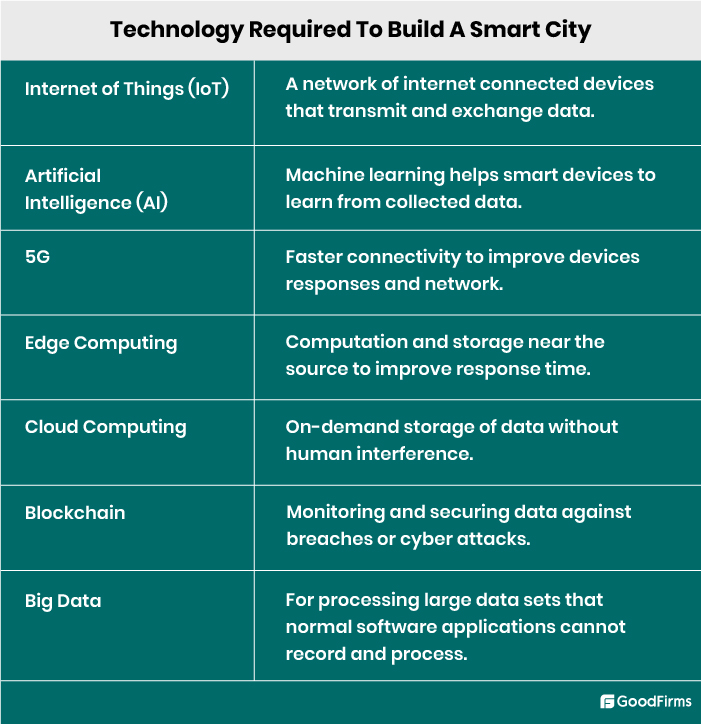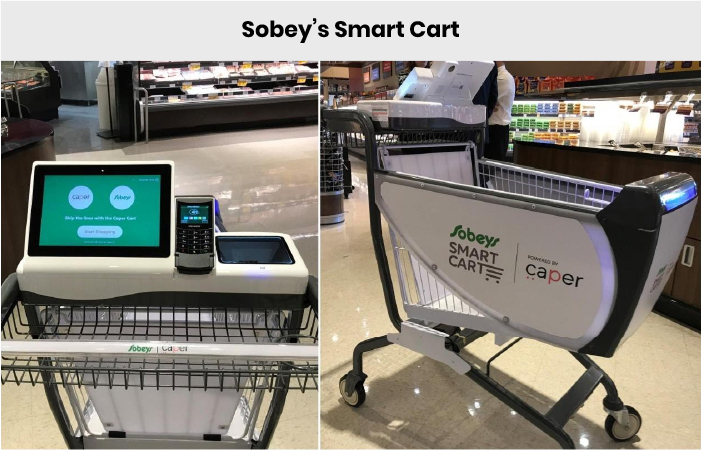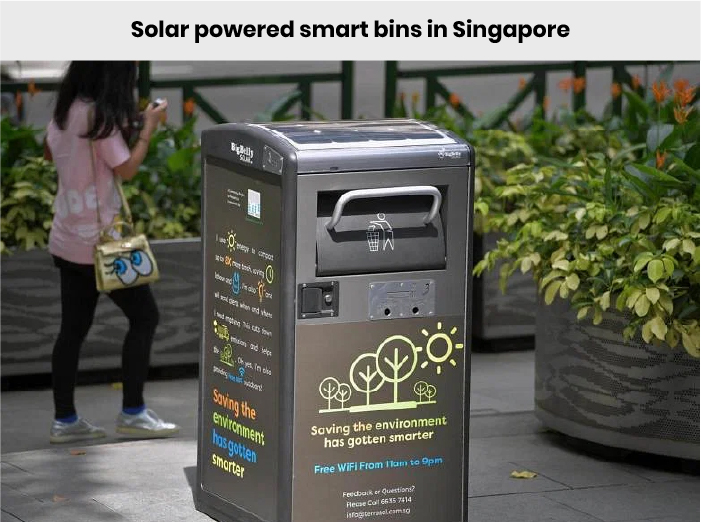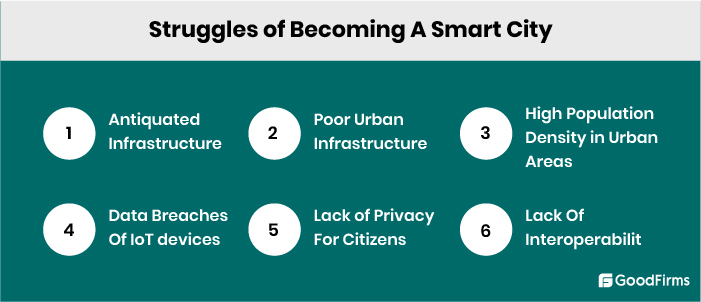The population across the world is growing and expected to rise in the coming years while the resources required to tackle the same are shrinking daily. On the brink of the next industrial-tech evolution, what other option do the governments of the world have to improve the lifestyle of their current and future citizens than adopting the modern solutions provided by Internet of Things (IoT), Artificial Intelligence (AI), and Edge Computing?
Gone are the days when just being a developed city was praiseworthy. What really gets the ball rolling today, is becoming a Smart City.

Envisioning Cities Through The Lens Of IoT
Smart cities have various definitions in different parts of the world, but the core of the concept remains the same. A city that uses IoT and ICT (Information and Communication Technology) to provide advanced infrastructure solutions to the people and community of that locality.
At the rate urbanization is expanding, governments and communities globally are aiming to reduce their carbon footprint and move towards a society that is more efficient in its lifestyle and function. And turning cities into smart cities is the best bet that policymakers globally are focusing their time, resources, and energy on right now.
Smart cities provide modern solutions to modern problems that we as citizens of the 21st century face in our daily lives. From efficient traffic management to water purification, everything is possible in smart cities with the help of smart devices.
Smart devices are small machines that are internet enabled and use wireless networks to make them mobile. By pairing these devices with IoT technology a city can easily monitor and remotely control the devices through software applications to perform different functions and transmit the collected data to cloud storages.

Hence, a fruitful partnership between leading IoT companies and local or state governments can turn your city into the next smart city!
City officials can remotely monitor and control a fleet of IoT based devices that optimize different welfare segments of the city to make it a smart city. Thus, IoT technology is at the heart of Smart Cities.
Smart cities also help improve urban planning and management, making the lives of the residents much easier at a reduced environmental impact and resource utilization. But doesn’t this make you wonder, just what all technologies play a part in turning a normal city into a smart city? So, here’s a list.
Technology Required To Build A Smart City:

For instance, a city might place a lot of IoT sensors to monitor traffic conditions. Data gathered is then transmitted over the 5G network. During this procedure, secure data transmission may be provided by blockchain technology. Then, traffic authorities can use edge computing analytics in real-time for data analysis, and AI can quickly sift through massive amounts of Big Data to forecast traffic flows and identify workable solutions to congestion, such as diverting traffic or changing traffic signal sequences. The dataset can then be kept for later use and study on a secure cloud network.
The Challenges of Rapid Urbanization
Urbanization is occurring at an accelerated rate in developed and developing countries. Today, nearly 4.4 billion people live in urban areas, namely cities, that is 56% of the world’s total population, and that number is only set to double by 2050 as per World Bank.
With overcrowding, air and water pollution, urban slums, and insecurity of human life, being the primary risks that the society is dealing with right now.
Lack of resources have put city planners and officials in a bind and they have turned to technology to adopt smart solutions to tackle these issues.
Governments of all nations vow to lower their national carbon emissions at each environmental summit they attend and have just begun to realise that the key to achieving those goals is to begin implementation of smart urban management at city wide levels.
The deteriorating air and water quality have been causing many serious health conditions that we as citizens of this planet are facing today. Cities have been overwhelmed with floods and inadequate waste management in recent years and we have all been a witness of these disasters irrespective of our geographical locations since these are common issues faced by a majority of cities across the globe.
Crime and poverty have been a common plague in the underdeveloped and developing countries for a long while but these issues are gaining momentum in even developed nations nowadays due to lacking infrastructure.
So how does a nation tackle these issues at such a scale? The dawn of smart cities has proven to be just the answer that the world was looking for. Let’s see how smart cities offer solutions to the challenges that rapid urbanization causes.
Smart City Solutions For Urbanization
City officials and the urban planning and management department can use IoT sensors to gather data about the urban landscape (air quality, water quality, waste management, transportation, traffic, law enforcement, hospitals, retails, etc) and use said data to solve problems in real time.
There are many different applications for smart city solutions. They can provide more efficient transportation routes, better and cost-effective water allocation, just-in-time waste disposal systems, implement efficient lighting and heating in buildings, and provide safer public areas.
While all this might sound a little futuristic, it is already in progress in many areas globally with intelligent traffic systems being the most common examples.
Use cases of smart solutions in cities:
1. Energy automation systems that control energy consumption in buildings to match with the number of people present and other external environmental conditions. The Building Automation Segment is expected to grow at a CAGR of 11.4% from 2022-27, with APAC being showing the highest expected growth.
2. Smart parking systems monitor the availability of parking space in streets and even in private parking lots to make parking cars a non-hassle and guide drivers to their parking spots. They even control the parking meter rates in accordance to the density of traffic in that area and the time in real-time.
The City of Westminster in London has adopted Smart Park to lower street congestion and cut vehicle emissions in the area. The City had 12000 parking spaces and officials found out that 30% of the traffic in the area was caused due to drivers looking for parking while 15% of the drivers were unaware of available parking spaces.
This caused traffic congestion and poor air quality in the area which is why city officials deployed 3000 sensors on the street and adopted Smart Park tech to solve their urban traffic issue.
3. Smart retails systems allow customers to shop, weigh, and scan their items to pay for them without any interference or support from humans. Although at first it may seem like an exercise in cutting jobs and replacing human workers, it is actually about making shopping a seamless experience with faster checkout.
Sobey’s in Canada introduced the smart cart technology for its customers in 2019 at their Oakville branch to make shopping more frictionless and intelligent. Customers simply have to scan the barcode on their items before putting them in the smart cart, while bulk items and produce are measured by weight so customers can simply put them in the cart which has a scale running underneath its basket and their price is automatically updated. The cart is reset after each item is added to the cart.
Customers who tested the smart cart in its pilot run, have called it intuitive and better than self checkout options.

4. Smart street lighting systems can help manage the city’s energy consumption and reduce excess consumption while significantly improving the lighting system through remote control and sensors.
Copenhagen switched to 20,000 smart LED lights from street lamps which brighten when they detect cyclists approaching, who make up almost half the city’s commute traffic, and dim whenever the street is sensed to be empty. This was an exercise in sustainability and to reduce excess unwanted consumption of energy.
Another great example of a wide scale smart city lighting infrastructure is the Chicago Smart Lighting Project launched in 2017. According to city officials, “In 2021, the City reduced its energy bill for streetlights by more than half, registering savings of $8.7 million. With energy prices on the rise, the City projects $100 million in savings over the first ten years.”
5. Smart waste management systems utilize the just-in-time methodology to prevent rubbish from being accumulated in high volumes in urban areas.
Being a developed nation Singapore is often in news to adopt the best and most sustainable living standards and practices. The city’s National Environment Agency (NEA) encourages smart solutions for efficient and effective management of waste.
It was recorded in 2018 that Singapore generated 8559 tonnes of garbage per day. The need for a smart waste management solution was glaringly obvious for the city officials. The city deployed various smart bins, one of which was a solar powered waste compacting bin, that detected when the bin was full and sent the data to authorities in real-time for collection of compact waste. The clean city network, created for smarter waste management, monitors the data from the fleet of smart bins to deploy garbage collection vehicles accordingly, reducing operational cost by nearly 80%. This is just one of the ways Singapore is using smart waste system to thrive towards a sustainable future.

6. Smart transportation systems solutions are pretty similar to smart traffic management systems where the traffic lights change colours depending on the vehicle flow and smart pavements. This solves the problem of traffic congestion and monitoring and controlling public transport more efficiently.
Seoul is one of the world leaders in smart mobility and they have adapted to the smart mobility/ transport mission since as early as 2003. Their smart transportation system is capable of warning the citizens of traffic problems and suggesting alternate routes in real-time.
The intelligent transportation system uses IoT sensors to collect data about the urban environment and uses AI to anticipate and advise traffic congestion solutions in real-time. In 2019, the city planned to invest in 5G transportation connectivity for advanced driver assistance systems on public transport like buses and taxis to enhance road safety and efficiency.
The metropolitan city partnered up with the leading mobile network provider, SK Telecom, to bring light to their vision and build a fleet of connected vehicles.
7. Smart water management systems encourage users to limit their water consumption and wastefulness with smart meters. Water is an essential commodity for an array of activities and industries apart from being the top substance for sustenance for humans.
Smart solutions for efficient water management can be deployed in reducing wastage and consumption in water-intensive industries such as agriculture. IoT companies can be commissioned to provide sensors for watching water quality, leakage issues, etc to reduce the consumption of water by nearly 20-30% in these industries.
Smart water meters are one of the leading solutions that are helping water-crisis-stricken countries like South Africa and Saudi Arabia to efficiently manage and monitor their water supply and consumption.
Not only this, IoT devices paired with AI and mobile communication have also proven to be immensely beneficial in flood risk management. Thane, a town in Maharashtra, has deployed Thane Urban Flood Alert Network (TUFAN), an IoT based early flood warning system to avoid water-logging and flooding in the city. The Thane Muncipal Corporation is spearheading many such smart solutions to deal with urban infrastructure problems through the help of modern technology.
8. Infectious disease surveillance emerged during the covid-19 pandemic to trace infected and affected individuals to limit exposure of the public and curb the spread of disease. Close to 50 countries developed such tracing apps during the pandemic.
China partnered up with Alipay and WeChat to roll out a system of health QR codes that used the traffic light system to indicate the health advisory for quarantine for individuals based on their activity and exposure to people who have been tested positive for covid-19.
Named as the Alipay Health Code, it was initially released in 200 cities before rolling out to the rest of the nation. The creators of Alipay Health Code say that it uses big data to suggest automated conclusions about whether someone is a contagion risk or not.

9. Predictive policing leverages AI to ensure the safety and security of the citizens of the city and uses digital tools to forecast crimes or required police intervention to prevent human harm and crime.
According to a study by Deloitte, cities have started investing in real time crime mapping, and gunshot detection through facial recognition and biometrics in public or crowded areas.
For instance, Delhi’s CMAPS (Crime Mapping Analytics and Predictive System) uses information gathered every three minutes from satellites operated by the Indian Space Research Organization, historical crime data, and the "Dial 100" helpline to pinpoint "crime hotspots," or places where crime is particularly prevalent.
Although this does raise the argument of data privacy, we can still hope that with the tech advancements that can also be managed soon but right now, ‘precaution is better than cure’ is the motto that governments seem to be choosing over privacy breaches.
The Struggles of Building A Smart City
The above examples and instances all speak for themselves displaying the strong allure of smart cities, they do come with their own set of problems. There are some serious challenges that need to be addressed before planning to build a smart city.
Old towns and cities with already existing urban infrastructure are more challenging to rebuild into smart cities than new or developing cities. The government has to take into account the antique infrastructure of the city before diving into the smart solutions that can be implemented in different areas.
Another hurdle is the high population density of urban areas which makes the planning and implementation much more difficult than it has to be. Smaller cities such as Helsinki, Finland with a population of approximately 1.3 million people are easier to turn into smart hubs than let’s say New York City with an estimated population of 18.8 million in 2022.
Other challenges that policymakers face while brainstorming the development plans for a smart city are:
- Data Breaches- IoT devices are infamous for their lacking security features and are often hacked/ hackable, disrupting service till human intervention. A direct pitfall of higher connectivity is smart systems being more prone to cyber attacks and data leaks.
- Lack Of Privacy- As mentioned above, a lot of these smart solutions toe the line of personal privacy breaches. Many people when exposed to this knowledge will be uncomfortable with the implications that their private information is privy to the government or their activities are in a sense being monitored and controlled.
- Lack Of Interoperability- The governments are outsourcing these smart projects to private companies, most often world-class leaders in their technological competencies but still belonging to the private sector. Bringing together a mesh of different technological networks to manage and operate a smart solution can be a difficult task in itself when each sector competes for control.
Apart from these, there are also legal, ethical, and environmental barriers that smart city planners can face while discussing the project.

West Vs East: Smart City Transformation
While the challenges mentioned above can be quite detrimental in the long-term for smart cities, in the present they do offer better solutions than their alternative of doing nothing and dealing with overpopulated and mismanaged urban cities.
The main difference between smart cities in the West and smart cities in the East lies in the fact that in the West this discussion and development is bottom-up, the private sector and citizens push through for the modernization of IoT solutions, while in the East it is top-down, wherein state and central government authorities seek out smart solutions.
In 2018, the Canadian government encouraged nearly 200 communities to participate in a competition to improve the quality of life through technology. It was then that Rogers, a predominant cellular and cable provider in the country introduced the Intelligent Cities Program. Local workshops for residents were conducted to help city officials create a better public transportation system with residents pinpointing the roadmaps.
Meanwhile in Asia, the smart city projects are formulated by the central government planning departments with the aim to improve governance. Case in point, India where the Government has taken several initiatives for IoT spending and presented plans of launching 100 smart cities, 500 rejuvenated cities, and other industrial hubs to nourish IoT potential in the country.
According to the World Economic Forum, India, China, and Nigeria are expected to account for nearly 35% of the projected growth in the world’s urban population by 2050. India has started the Vande Bharat express, India’s first semi-high speed train, between the capital city of New Delhi and Varanasi, a city in the state of Uttar Pradesh, that uses a collision-avoidance system comprising sensors and other IoT devices to prevent accidents due to human error or equipment failure. In the field of agriculture, Tea Tantrum, a premium supplier of wellness teas in India, is using IoT to monitor moisture content and maintain the ingredient proportions of some of its products.
This small examples display the vast potential of IoT technology in the Indian subcontinent.

This shows that although the Western cities are renowned for their developed lifestyle, it may take some years for them to fully match the legacy of the fast developing cities in the East mainly as it requires nurturing a harmony and collaboration between governments and industries, by putting aside their capitalist mentality.
In summary
Tempted by the higher living standards of the urban cities, people flock to them in masses and saturate their capacity to function efficiently. The smart city solutions we read about today aim to tackle these problems to achieve a sustainable society where technology can improve and ease the burden we have put on our limited resources.
A smart city can monitor the air quality and also the health records of its citizens by integrating various technologies to create a futuristic reality for its inhabitants. The step to upgrade the city and meet the needs of it’s modern citizens is a call that sooner or later every government will have to answer, so till then let’s just wait and enjoy the wonders of the modern world.



